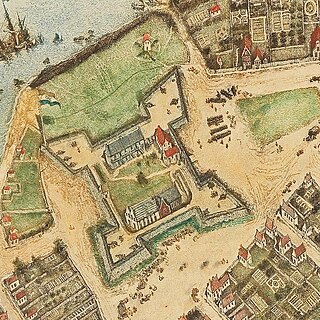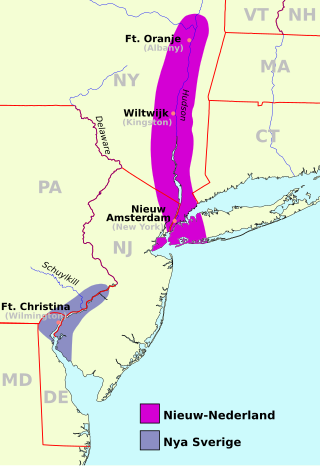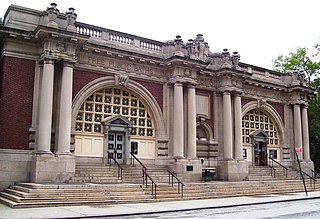Related Research Articles

New Amsterdam was a 17th-century Dutch settlement established at the southern tip of Manhattan Island that served as the seat of the colonial government in New Netherland. The initial trading factory gave rise to the settlement around Fort Amsterdam. The fort was situated on the strategic southern tip of the island of Manhattan and was meant to defend the fur trade operations of the Dutch West India Company in the North River. In 1624, it became a provincial extension of the Dutch Republic and was designated as the capital of the province in 1625.

Peter Stuyvesant was a Dutch colonial officer who served as the last Dutch director-general of the colony of New Netherland from 1647 until it was ceded provisionally to the English in 1664, after which it was split into New York and New Jersey with lesser territory becoming parts of other colonies, and later, states. He was a major figure in the early history of New York City and his name has been given to various landmarks and points of interest throughout the city.

New Netherland was a 17th-century colonial province of the Dutch Republic located on the east coast of what is now the United States. The claimed territories extended from the Delmarva Peninsula to southwestern Cape Cod, while limited settlements were in parts of the U.S. states of New York, New Jersey, Delaware, and Connecticut, with small outposts in Pennsylvania and Rhode Island.

Fort Amsterdam was a fortification on the southern tip of Manhattan Island at the confluence of the Hudson and East rivers. The fort and the island were the center of trade and the administrative headquarters for the Dutch and then British/Colonial rule of the colony, of New Netherland and thereafter the Province of New York. The fort was the nucleus of the settlement on the island which was named New Amsterdam and eventually renamed New York by the English, and was central to much of New York's early history.

Fort Orange was the first permanent Dutch settlement in New Netherland; the present-day city of Albany, New York developed at this site. It was built in 1624 as a replacement for Fort Nassau, which had been built on nearby Castle Island and served as a trading post until 1617 or 1618, when it was abandoned due to frequent flooding. Both forts were named in honor of the Dutch House of Orange-Nassau. Due to a dispute between the Director-General of New Netherland and the patroonship of Rensselaerswyck regarding jurisdiction over the fort and the surrounding community, the fort and community became an independent municipality, paving the way for the future city of Albany. After the English reconquered the region they soon abandoned Fort Orange in favor of a new fort: Fort Frederick, constructed in 1676.
This is a list of Directors, appointed by the Dutch West India Company, of the 17th century Dutch province of New Netherland in North America. Only the last, Peter Stuyvesant, held the title of Director General. As the colony grew, citizens advisory boards – known as the Twelve Men, Eight Men, and Nine Men – exerted more influence on the director and thus affairs of province.

The Peach Tree War, also known as the Peach War, was a large-scale attack on September 15, 1655 by the Susquehannock Indians and allied tribes on several New Netherland settlements along the North River.

Fort Casimir or Fort Trinity was a Dutch fort in the seventeenth-century colony of New Netherland. It was located on a no-longer existing barrier island at the end of Chestnut Street in what is now New Castle, Delaware.

Pavonia was the first European settlement on the west bank of the North River that was part of the seventeenth-century province of New Netherland in what would become the present Hudson County, New Jersey.

Bergen was a part of the 17th century province of New Netherland, in the area in northeastern New Jersey along the Hudson and Hackensack Rivers that would become contemporary Hudson and Bergen Counties. Though it only officially existed as an independent municipality from 1661, with the founding of a village at Bergen Square, Bergen began as a factory at Communipaw circa 1615 and was first settled in 1630 as Pavonia. These early settlements were along the banks of the North River across from New Amsterdam, under whose jurisdiction they fell.

Knight Michiel Reiniersz Pauw (born 29 March 1590 – died 20th, buried 24 March 1640 at Nieuwe Kerk, Amsterdam was a director of the Dutch West India Company between 1621-1636.
Nicholas Bayard was a government official and slave trader in colonial New York. Bayard served as the mayor of New York City from 1685 to 1686. He is historically most notable for being Peter Stuyvesant's nephew and for being a prominent member of the Bayard family, which remained prominent in New York City history into the 20th century.

Asser Levy, also known as Asser Levy van Swellem and Asher Levy, was one of the first Jewish settlers of the Dutch colony of New Amsterdam on Manhattan Island.

Colonel Philip Pieterse Schuyler or Philip Pieterse was a Dutch-born colonist landowner who was the progenitor of the American Schuyler family.

Wilhelmus Hendricksen Beekman – also known as William Beekman and Willem Beekman – was a Dutch immigrant to America who came to New Amsterdam from the Netherlands in the same vessel with Director-General and later Governor Peter Stuyvesant.

Johannes Megapolensis (1603–1670) was a dominie (pastor) of the Dutch Reformed Church in the Dutch colony of New Netherland, beginning in 1642. Serving for several years at Fort Orange on the upper Hudson River, he is credited with being the first Protestant missionary to the Indians in North America. He later served as a minister in Fort Amsterdam on Manhattan Island, staying through the takeover by the English in 1664.

The Articles of Capitulation on the Reduction of New Netherland was a document of surrender signed on September 29, 1664 handing control of the Dutch Republic's colonial province New Netherland to the Kingdom of England.

The conquest of New Netherland occurred in 1664 as an English expedition led by Richard Nicolls that arrived in New York Harbor effected a peaceful capture of New Amsterdam, Fort Amsterdam and the Articles of Surrender of New Netherland were agreed. The conquest was mostly peaceful in the rest of the colony as well, except for some fighting in New Amstel.
References
- 1 2 Bayles, R. M. (1887). History of Richmond County (Staten Island), New York: From Its Discovery to the Present Time. L. E. Preston & Company.
- ↑ History of the City of New York in the Seventeenth Century, Volume 1 By Mariana Griswold Van Rensselaer 2013 pages 491, 526